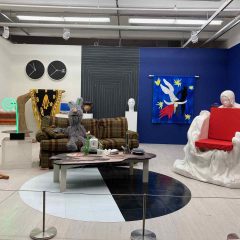Post by Andrea Kirsh

Fiona Foley’s HHH #4, 2004, ultrachrome print on paper, 101 x 76cm., Niagara Galleries, Melbourne (Photo: courtesy of the artist and Niagara Galleries, Melbourne)
Is feminism fashionable in the artworld? One could be forgiven for thinking so, given two major exhibitions :
“Wack; Art and the Feminist Revolution” organized by LAMoCA (see Libby’s post here), where it opened recently. It will travel to the National Museum of Women in the Arts, D.C. and P.S. 1, NYC and…
“Global Feminisms” which opened two weeks ago at the Brooklyn Museum…
as well as recent symposia at two major NYC museums:
at MoMA , January 26-7: The Feminist Future; Theory and Practice in The Visual Arts (audio recording available) and…
at the Brooklyn Museum March 31: “Feminism without Borders”
I attended the symposium in Brooklyn; perhaps the most hopeful sign of all was the number of young women (and occasional man) in the audience. One hears that the “f” word is shunned by women too young to remember the days before Roe v. Wade, Title 9, and non-discriminatory hiring laws. Apparently not entirely.
The morning session was chaired by Linda Nochlin, co-curator of “Global Feminisms” and the scholar who opened up the field of feminist art history with her 1971 article “Why have there been no great women artists?” If you haven’t read it, she pointed to institutional issues, mainly the lack of access to proper artistic education.

The panel, including Xabier Arakistain with the big hair next to session chair Linda Nochlin, at far right. Photo by Lori DiCola, an art history grad student at Temple University.
The panel’s entrance was a bit of visual theater: Linda in black, accessorized with a wonderful apricot-colored scarf and jewelry, and yellow sandals; followed by Xabier Arakistain, a curator from Spain who is 6 foot 2 inches and was entirely in black, including his remarkable hair which improbably managed to approach the heights of the hats worn by the guards at Buckingham Palace; he was also wearing rather more dark eye make-up and red lipstick than one usually sees in the mornings, even in New York; and at the end of the procession, Abigail Solomon-Godeau, critic and art historian (also in black), her face mostly hidden behind sun-glasses; she told us later that she’d lost her ordinary glasses.

Joe Martin Hill helps performance artist Tracey Rose adjust her earring. Photo by Lori DiCola.
The theater continued when the South African artist, Tracey Rose, stood to give her presentation. She spit out her chewing-gum, pulled a skirt over her jeans which she then removed; put on panty-hose and bound up her long hair; then put on earrings, which required her to ask help of her neighbor, the curator Joe Martin Hill (quite a test of his sangfroid). Needless to say, her presentation was intended as a performance, and the costuming was followed by a dialogue using socks as hand-puppets.

Anna Baumgart (Poland, b. 1966), Ecstatic, Hysteric, and Other Saintly Ladies (Ekstatyczki, histeryczki i inne ´swiete), 2004, Video, color, sound, 11 min., Lent by the artist and Zacheta National Gallery of Art, Warsaw (Photo: courtesy of the artist)
Both the symposium and the Brooklyn exhibition expanded the Euro-American focus which characterized first and second-wave feminism. A number of the speakers (talking about China, Morocco, South Africa, the Balkans and elsewhere) said that the word “feminism” isn’t pertinent, despite the art from those places addressing issues for which we’d use the term. It was exciting to see the range of work produced in places unknown – but if you intend to see the exhibition, plan on a very long day. There’s lots and lots of video, which I thought much of the most interesting work. Lots of photography, as well. And various work that’s harder to characterize; one of my favorites was Parastou Forouhar’s “Thousand and One Day” – wallpaper with torture scenes in pink and black that read as bland decoration from the distance.
I hope all this activity doesn’t suggest a fashion; half the population is too important to be relegated to a passing interest.
–Andrea Kirsh is an art historian based in Philadelphia. You can read her newest Philadelphia Introductions and other commentary at InLiquid.









